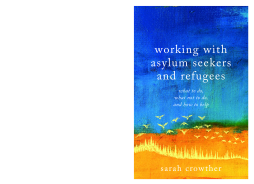
Additional Information
Book Details
Abstract
This hands-on guide provides accessible, insightful advice for practitioners who find themselves working with asylum seekers and refugees. Part I covers the essentials of understanding refugees' experiences including what they are coping with now they are in the UK, definitions, entitlements and restrictions, equality, positive action, and practical engagement including improving access to services and overcoming language barriers. Part II prepares professionals for meeting a wide range of needs, including housing, poverty, health and mental health, and training and employment. It also cover issues and opportunities when working with child and young refugees.
This pragmatic book accompanies social workers, medical staff, educators, charity workers and housing professionals in their daily work, and illustrates the perspective of refugees themselves. A passionate and compassionate response to the needs of displaced people, it is an excellent starting point for all those working to create a safe and welcoming environment where refugees and asylum seekers are supported.
Table of Contents
| Section Title | Page | Action | Price |
|---|---|---|---|
| Working with Asylum Seekers and Refugees: What to Do, What Not to Do, and How to Help by Sarah Crowther | 3 | ||
| Foreword by Debora Singer MBE | 12 | ||
| Acknowledgements | 13 | ||
| 1. Introduction | 15 | ||
| What do we expect? | 15 | ||
| Why this book and who is it for? | 16 | ||
| Why this book now – has something changed? | 17 | ||
| Ordinary, unique, active | 21 | ||
| Learning from refugees and this book | 25 | ||
| 2. Why it Matters | 27 | ||
| Introduction | 27 | ||
| Question 1: Does it matter whether or not hands-on staff support refugees? | 27 | ||
| Doubts and concerns about whether to support refugees | 29 | ||
| Question 2: Does it matter whether the people I am supporting are refugees or not refugees? | 33 | ||
| Summary and conclusion | 39 | ||
| 3. Defining ‘Refugee’ and Practical Entitlements – on a ‘Need to Know’ Basis | 41 | ||
| Introduction | 41 | ||
| A subjective definition of ‘refugee’ – based on people’s experiences | 42 | ||
| Home Office definitions of ‘refugee’ – based on future likelihood | 44 | ||
| Popular and political definitions and confusion | 55 | ||
| Entitlements to publicly funded support and services | 57 | ||
| Summary and conclusion | 61 | ||
| 4. Refugees in All Their Diversity – Equality, Discrimination and Positive Action | 64 | ||
| Introduction | 64 | ||
| Protecting refugees from discrimination after they arrive in the UK | 66 | ||
| What you mustn’t do | 69 | ||
| What you can do to improve equality | 73 | ||
| The Public Sector Equality Duty (PSED) – what they (and you) must do | 77 | ||
| Summary and conclusion | 80 | ||
| 5. Engaging with Refugees | 82 | ||
| Introduction | 82 | ||
| Access | 83 | ||
| Motives, means and opportunities – reflect and boost | 88 | ||
| How to engage – initiating a relationships | 95 | ||
| Face-to-face engagement | 97 | ||
| Longer-term relationships | 100 | ||
| Summary and conclusion | 105 | ||
| 6. Communicating in English – Plain English, Interpreters and Learning English | 107 | ||
| Introduction | 107 | ||
| Narrow the gap | 107 | ||
| Bridge the gap | 109 | ||
| Learning English to close the gap | 111 | ||
| A ‘grass roots’ model for volunteer-led English group sessions | 111 | ||
| 7. Other Organisations, Networking and Advocating for Refugees | 115 | ||
| Introduction | 115 | ||
| The importance of networking | 115 | ||
| Referral and the ‘One plus One’ principle | 119 | ||
| Tackling third parties for your refugee clients – advocacy, complaints and influence | 120 | ||
| Summary | 129 | ||
| Blank Page |
